Occlusion: Warm Conveyor Belt Type - Meteorological Physical Background
by ZAMG
The classical Norwegian model
The classical development of an Occlusion is described in the well-known polar front theory after Bergeron as a development from a Wave stage (see Wave) with a well developed Cold Front (see Cold Front, Cold Front In Cold Advection, Cold Front In Warm Advection, Split Front and Arctic Cold Front) and Warm Front (see Warm Front Band, Warm Front Shield and Detached Warm Front). The basic idea is that the Cold Front moves faster than the Warm Front. Therefore the warm sector continuously becomes more narrow until finally the Cold Front overtakes the Warm Front completely, thereby lifting the warm air. This is the typical situation for the Occlusion band which turns cyclonically around the core of the cyclone.
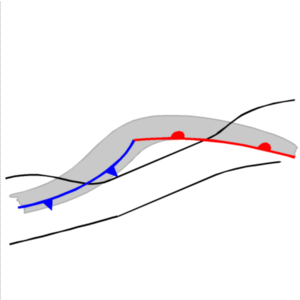
|
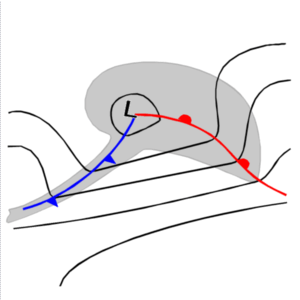
|
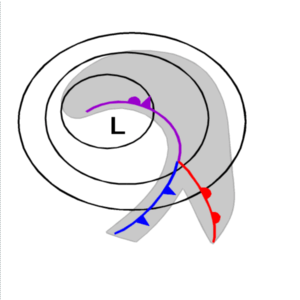
|
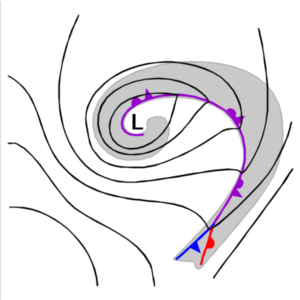
|
- If the air situated in front of the Warm Front has about the same temperature as the air situated behind, the temperature gradient dissolves during the process of the Occlusion. In this case the Occlusion is characterized only by a line of cyclonic shear and convergence which can be found vertically below the merging point of both fronts.
- If the air situated in front of the Warm Front is colder than the air behind, a so-called Warm Front Occlusion develops which has a forward inclined frontal surface.
- If the air situated in front of the Warm Front is warmer than the air behind, a so-called Cold Front Occlusion develops which has a backward inclined frontal surface.
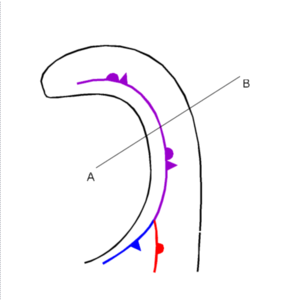
|
Warm Occlusion
|
Cold Occlusion
|
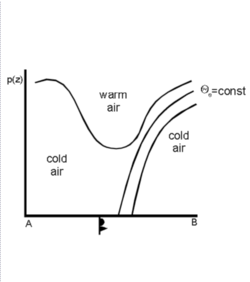
|
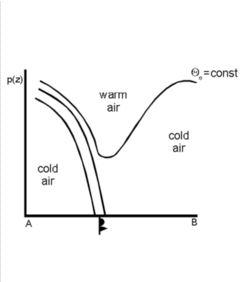
|
Deviations between cloud configurations in satellite images and the classical Norwegian model
Very soon after the use and study of satellite images it became clear that this idealized theory cannot be observed in every step and detail in reality. In particular, the overtaking of the Warm Front by the Cold Front with very narrow warm sectors can never be seen (left schematic). Instead of this a mergence of Cold and Warm Front cloudiness in the centre of the surface low takes place followed by a westward extension of the Occlusion cloud spiral, while the Warm Front cloudiness becomes shorter (right schematic).
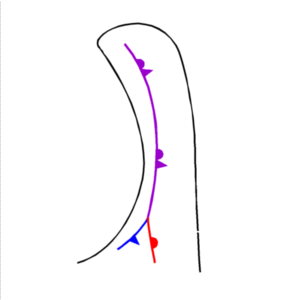
|
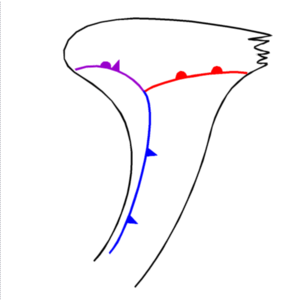
|
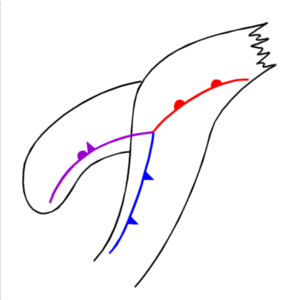
Conveyor Belt model
This theory is not an independent new model, but allows a different insight into the same phenomena of the Occlusion process. It shows a much bigger variety of development possibilities and clearly indicates that the Occlusion development described by the Norwegian model represents only a special case.The conveyor belt theory for the Cold Front deals predominantly with two relative streams: the warm conveyor belt and the dry intrusion. The warm front deals predominantly with the relative streams of the warm conveyor belt and the cold conveyor belt. For the Occlusion all three conveyor belts are relevant:
- The warm conveyor belt is a rising relative stream from south, south-eastern directions turning to north, north-eastern directions; it transports warm and moist air.
- The dry intrusion is a sinking relative stream from north-west to south-east, splitting into two branches: a
further sinking one to the south-west and a rising one to the north-east.
The cold conveyor belt is a rising relative stream from east, south-east which is initially below the warm conveyor belt, but then emerges from below and extends to northern directions.
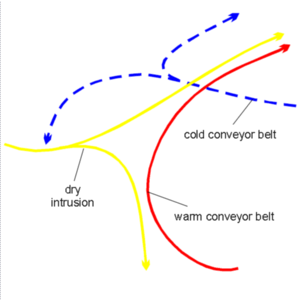
The structure and formation of the cloud spiral of the warm conveyor belt Occlusion type can also be described with the conveyor belt theory as follows:
- An ascending cold conveyor belt can be found parallel to the surface warm front. At the point of the Occlusion it penetrates from below the warm conveyor belt and turns cyclonically forming the cloud spiral. The relative stream of the cold conveyor belt is a main relative stream forming the Occlusion cloud band. In this Occlusion type it is hidden below higher level cloudiness which is related to the middle and upper level streams. Within the cyclonic turn the ascending motion changes into a descending motion which causes the decrease of the frontal cloud tops.
- The higher levels of the troposphere are characterized by the relative streams of the warm conveyor belt and the dry intrusion. The configuration of the warm conveyor belt depends on the stage of development. In the early wave stage the warm conveyor belt ascends within the cloud band of the Cold and Warm Front where it turns anticyclonically parallel to the surface warm front (see Warm Front Band). During the warm conveyor belt type of the Occlusion development, described in this chapter, the warm conveyor belt develops to a ridge-like hook over the occlusion band and later on splits into two parts: the eastern branch follows the cloud band of the Warm Front while on the western branch it follows the cloud spiral of the Occlusion. This is the main difference to the Cold Conveyor Belt Type Occlusion, because in the warm conveyor belt cloudiness develops and forms the multilevel Occlusion cloud band. The cloud bands of the warm and the cold conveyor belt are often distinct.
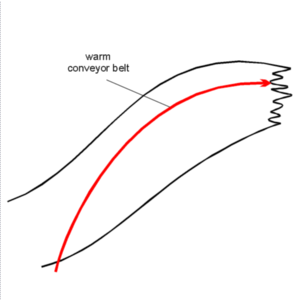
|
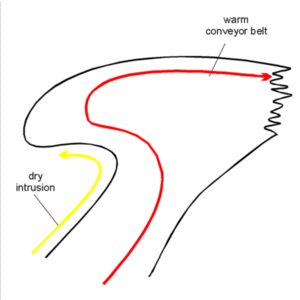
|
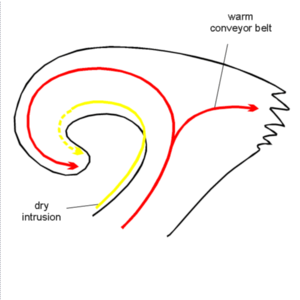
|
- The dry intrusion is accompanied by descending air originating from the upper levels of the troposphere and/or the lower
levels of the stratosphere. The dry intrusion is approximately to the rear cloud edge of the cloud spiral of the Occlusion.
If at all it overruns only the boundary zones of the cloud band. These are the areas predestined for the development of Cb
Cloudiness, which often can be observed in the images (see Cloud structure in satellite image) as well as in the
synoptic weather reports (see Weather events). The following reasons for the convective development can be found:
- the air advected within the dry intrusion has lower values of relative humidity than the air of the cold conveyor belt; this leads to the development of a conditionally unstable stratification;
- a PVA maximum indicating moving curvature vorticity contributes to upward motion according to the omega equation.
- The fact that the dry intrusion does not cross the Occlusion cloud band in this warm conveyor belt development type is another big difference from the cold conveyor belt type (see Occlusion: Cold Conveyor Belt Type - Meteorological physical background ).
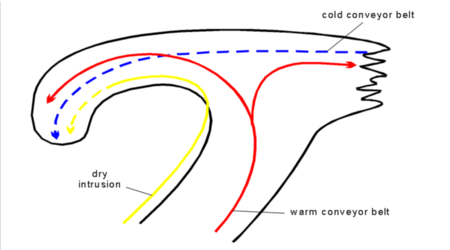
Discussion
A comprehensive study at ZAMG of all occlusion events during one year shows many of the mentioned points described above, but also some deviations. These facts can be summarized as follows:- Classical Occlusion developments like the one described in this chapter occur rather seldom.
- In every case a cold conveyor belt, as described above, could be observed.
- Whether a Warm Conveyor Belt Occlusion type or a Cold Conveyor Belt Occlusion type develops seems to depend on the stage of development of the cyclone. If the height field in the mid- and upper levels of the troposphere displays a closed cyclonic circulation, the Warm Conveyor Belt Occlusion cloud spiral characterized by multilevel cloudiness is likely (see Key parameters). This is another difference between the two types of Occlusion (see Occlusion: Cold Conveyor Belt Type - Cloud structure in satellite image ) and could be a tool for an early discrimination.
- The behaviour of the warm conveyor belt is very similar to the one described above with one exception: while the hook form of the warm conveyor belt can clearly be observed, the splitting into two branches never appeared.
- As described for the Cold Front, not only is the warm conveyor belt responsible for the Cold and Warm Front cloudiness, but also the upper relative stream transporting moist air at the anticyclonic side of the jet. Consequently the upper relative stream is also involved in the Occlusion process. For the higher isentropic surfaces it is even the more dominant and important relative stream. Like the warm conveyor belt within the mid-isentropic surfaces, the upper relative stream also develops a hook form in the upper tropospheric surfaces. A splitting during the mature stage of development could not be observed.
- The configuration of the dry intrusion could also be observed, as well as the area with convective development. But the course of the stream lines of the innermost part of the cloud spiral could not clearly be distinguished; very often it overruns the cloud spiral.
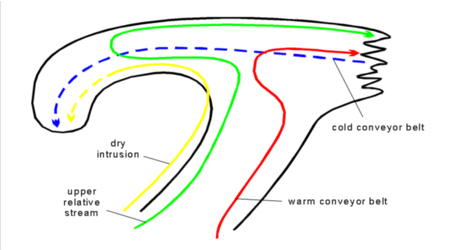
- It has to be stressed that in a high percentage of cases the initial stage of an Occlusion process has cold conveyor belt features even if a multilevel cloud spiral soon develops.
|
21 October 1996/18.00 UTC - Vertical cross section; black: isentropes (ThetaE), blue: relative humidity, orange thin: IR
pixel values, orange thick: WV pixel values
|
21 October 1996/18.00 UTC - Meteosat IR image; magenta: relative streams 305K - system velocity: 206° 13 m/s, yellow:
isobars 305K, position of vertical cross section indicated
|
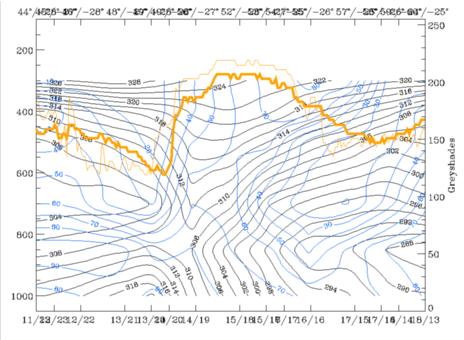
|
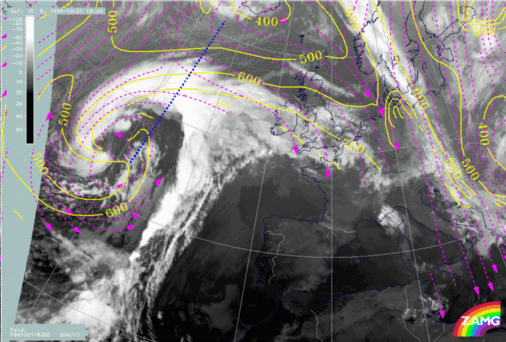
|
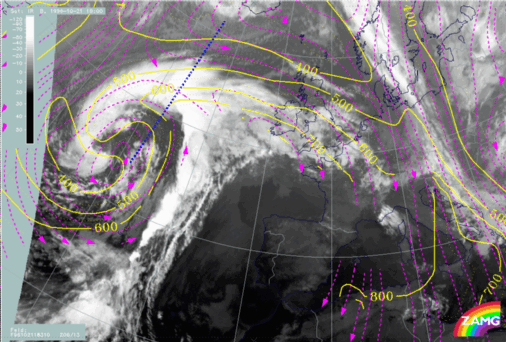
|
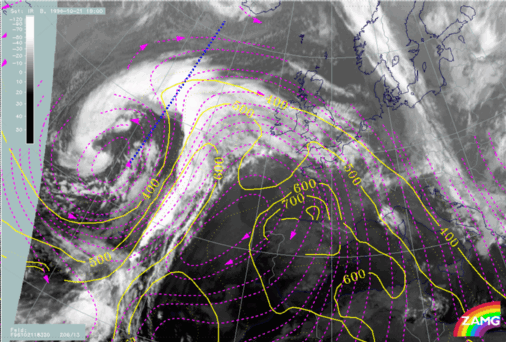
|
|
21 October 1996/18.00 UTC - Meteosat IR image; magenta: relative streams 310K - system velocity: 206° 13 m/s, yellow:
isobars 310K, position of vertical cross section indicated
|
21 October 1996/18.00 UTC - Meteosat IR image; magenta: relative streams 320K - system velocity: 206° 13 m/s, yellow:
isobars 320K, position of vertical cross section indicated
|
On the isentropic surface of 305K the cold conveyor belt can be observed within the cloud spiral.
A cold conveyor belt can still be observed on the isentropic surface of 310K but the innermost parts of the cloud spiral are already overrun by the dry intrusion.
On the isentropic surface of 320K the hook form of the upper relative stream accompanies a large part of the Occlusion cloudiness. For this the assumption has to be made that the zero line of shear vorticity does not cut the cloud band as computed by the numerical model, but follows the rear cloud edge and is connected to the western zero line of the shear vorticity.


